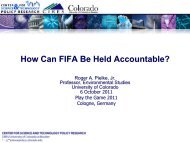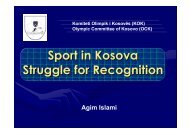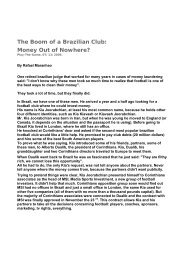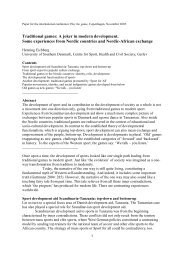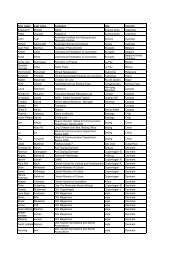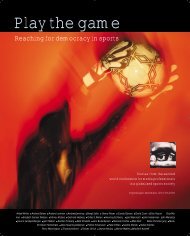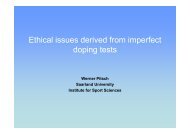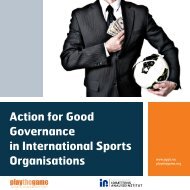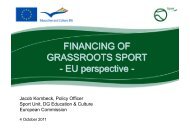Physical literacy in primary school children - Play the Game
Physical literacy in primary school children - Play the Game
Physical literacy in primary school children - Play the Game
Create successful ePaper yourself
Turn your PDF publications into a flip-book with our unique Google optimized e-Paper software.
<strong>Physical</strong> <strong>literacy</strong> <strong>in</strong> <strong>primary</strong><br />
<strong>school</strong> <strong>children</strong><br />
Dawson, S.L., Oxford, S., Virdee, R. & Drake, A.<br />
Presented by Dr Samantha Dawson
Objectives<br />
• Detail <strong>the</strong> current obesity rates, physical<br />
activity levels and recommended guidel<strong>in</strong>es for<br />
<strong>primary</strong> aged <strong>school</strong> <strong>children</strong><br />
• F<strong>in</strong>d<strong>in</strong>gs of a recent study we have conducted<br />
• Suggest why focus<strong>in</strong>g on movement tra<strong>in</strong><strong>in</strong>g<br />
skills (MTS) may be a piece <strong>in</strong> <strong>the</strong> jigsaw<br />
towards chang<strong>in</strong>g <strong>the</strong> future health of <strong>the</strong><br />
nation, keep<strong>in</strong>g teenagers out of trouble and<br />
improv<strong>in</strong>g <strong>the</strong> future of British sport
Background<br />
The NCMP (2007/08) revealed that<br />
26.4% of Reception and 39.7% of Year 6<br />
<strong>children</strong> <strong>in</strong> Coventry are overweight or<br />
obese<br />
National average: 25.4% and 37.5%<br />
respectively<br />
Debate for <strong>the</strong> causes of <strong>in</strong>creased<br />
pediatric obesity
Evidence <strong>in</strong>dicates that physical<br />
<strong>in</strong>activity plays a contribut<strong>in</strong>g role<br />
(Hills et al., 2007)<br />
Opportunities for <strong>children</strong> to be<br />
active are decl<strong>in</strong><strong>in</strong>g (car journeys to<br />
<strong>school</strong> have doubled, safety outside,<br />
computer games, money etc)<br />
Time devoted to PE = 2 hours/week<br />
Activity dur<strong>in</strong>g <strong>the</strong>se sessions?
• Only 1/3 of UK <strong>children</strong> aged 2-11 years old<br />
meet physical activity guidel<strong>in</strong>es<br />
• Guidel<strong>in</strong>es have changed over <strong>the</strong> years:<br />
– 30 m<strong>in</strong> of moderate- vigorous activity per day<br />
(ACSM, 1988)<br />
– 60 m<strong>in</strong>/day and twice a week exercise to<br />
improve bone health, muscular strength and<br />
flexibility (Biddle et al., 1998)<br />
– 90 m<strong>in</strong> of moderate <strong>in</strong>tensity activity per day<br />
(Anderson et al., 2006)
• How do we reverse <strong>the</strong> trend???
• Exercise participation decl<strong>in</strong>es from childhood to<br />
adolescence (Gorely et al., 2004)<br />
• Fitness <strong>in</strong> adolescence is closely related to fitness<br />
<strong>in</strong> adulthood (Twisk et al., 1995)<br />
• Adolescents not participat<strong>in</strong>g <strong>in</strong> regular<br />
sport/activity are possibly more likely to hang<br />
around on <strong>the</strong> streets<br />
• Target<strong>in</strong>g adolescent years= too late!!!<br />
• Need to target <strong>primary</strong> <strong>school</strong> <strong>children</strong>.
<strong>Physical</strong> <strong>literacy</strong><br />
• Term under constant review<br />
• Literacy thought to <strong>in</strong>clude components of<br />
knowledge, understand<strong>in</strong>g, th<strong>in</strong>k<strong>in</strong>g, communication<br />
& application (Mandigo et al., 2003)<br />
• To be physically literate a person moves with poise,<br />
economy and confidence across a variety of<br />
activities (Whitehead, 2001)<br />
• More recent def<strong>in</strong>itions <strong>in</strong>clude importance of<br />
culture, self-esteem, motivation and social<br />
responsibility
• The development of physical <strong>literacy</strong> starts<br />
with <strong>the</strong> development of fundamental<br />
motor skills (LTAD model)<br />
• Motor development models suggest many<br />
levels through which a child must progress<br />
to achieve motor proficiency…<br />
Exercise<br />
Physiology<br />
Biomechanics<br />
Motor learn<strong>in</strong>g/<br />
control<br />
Psychology
• Mastery of fundamental motor skills/<br />
movement skills provides <strong>the</strong> foundation for<br />
<strong>the</strong> development of sport specific skills<br />
(Haubenstricker & Seefeldt, 1986)<br />
• Motor skill proficiency tracks with<br />
childhood (Branta et al., 1984) <strong>the</strong>refore<br />
do <strong>children</strong> with better motor skills become<br />
more active teenagers?? And thus adults??
The study<br />
• Does a 15 m<strong>in</strong> active warm-up<br />
(<strong>in</strong>clud<strong>in</strong>g MTS) impact upon agility<br />
performance <strong>in</strong> <strong>primary</strong> <strong>school</strong><br />
<strong>children</strong>?
Methods<br />
• 29 year 5 (Mean age 9.6 ± 0.5 years) <strong>children</strong><br />
from a local <strong>primary</strong> <strong>school</strong><br />
• Quickest of 3 Ill<strong>in</strong>ois agility tests recorded and<br />
ranked <strong>in</strong> order (quickest to slowest)<br />
• Class split <strong>in</strong>to 2 equal ability groups<br />
• One group received 15 m<strong>in</strong> warmup at beg<strong>in</strong>n<strong>in</strong>g<br />
of every PE lesson for 4 weeks (8 sessions)<br />
• Control group performed normal PE lesson<br />
• HR cont<strong>in</strong>uously recorded for 3 <strong>children</strong> <strong>in</strong> each<br />
group<br />
– 2 factor ANOVA analysed <strong>the</strong> results
5 yards<br />
10 Yards
Results<br />
• No significant differences (P >0.05)<strong>in</strong><br />
agility performance times with<strong>in</strong> or<br />
between <strong>the</strong> experimental and control<br />
groups both pre (21.5 ± 1.59 and 21.7<br />
± 1.52 sec respectively) and post<br />
<strong>in</strong>tervention (21.4 ± 1.47 sec and 21.3<br />
± 1.59 sec respectively)
Heart rate data<br />
• The percentage of time spent <strong>in</strong><br />
various HR zones (165<br />
beats.m<strong>in</strong> -1 ) were calculated, dur<strong>in</strong>g<br />
MTS 13.7%, 38% and 48.3% of time<br />
was spent <strong>in</strong> each HR zone<br />
respectively, compared with 21%,<br />
47% and 32% <strong>in</strong> PE.
Conclusions<br />
• 8 x 15 m<strong>in</strong>ute sessions of MTS is not<br />
adequate to see improvements <strong>in</strong> agility<br />
performance of <strong>primary</strong> <strong>school</strong> <strong>children</strong><br />
• Heart rate is significantly higher for a<br />
longer period of time dur<strong>in</strong>g <strong>the</strong> MTS<br />
warm-up (P
References<br />
• Anderson, L.B., Harro, M., et al. (2006) <strong>Physical</strong> activity and clustered<br />
cardiovascular risk <strong>in</strong> <strong>children</strong>: a cross sectional study. European Youth<br />
Heart Study. The Lancet 368 299-304<br />
• Barnett, L.M., Van Beurden, E., Morgan, P.J., Brooks, L.O. & Beard, J.R.<br />
(2008) Does childhoos Motor Skill Proficiency Predict Adolsecent Fitness?<br />
Medic<strong>in</strong>e & Science <strong>in</strong> Sports & Exercise 40 2137-2144<br />
• Branta, C., Haubenstricker, J., and Seefeldt, V. Age changes <strong>in</strong> motor<br />
skills dur<strong>in</strong>g childhood and adolescence. Exercise and Sport Science<br />
Reviews 12 467-520<br />
• Haubenstricker, J. and Seefeldt, V. (1986) Acquisition of motor skills<br />
dur<strong>in</strong>g childhood. In Reston, V. editor. <strong>Physical</strong> activity and well-be<strong>in</strong>g.<br />
AAHPERD, p41-92<br />
• Hills, A., K<strong>in</strong>g, N., & Armstrong, T. (2007)The contribution of physical<br />
activity and sedentary behaviors to <strong>the</strong> growth and development of<br />
<strong>children</strong> and adolescents: implications for overweight and obesity. Sports<br />
Medic<strong>in</strong>e 32 533-545<br />
• NCMP (2007/2008) http://www.ncmp.ic.nhs.uk/newresults.aspx
Thank you for listen<strong>in</strong>g
Warm-up sessions<br />
• Session 1: Runn<strong>in</strong>g mechanics<br />
• Sessions 2-8:<br />
7 m<strong>in</strong> drills (across 10 m track) <strong>in</strong>clud<strong>in</strong>g<br />
walk<strong>in</strong>g, skip, butt flick, fast feet, high<br />
knees, strides, turn<strong>in</strong>g.<br />
8 m<strong>in</strong> games developed to <strong>in</strong>crease HR,<br />
work on skills to improve speed and agility






